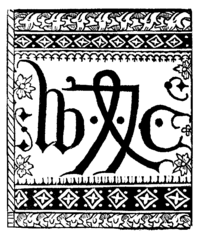- Dictes and Sayings of the Philosophers
-
 Imaginary portrait of Caxton, 1819
Imaginary portrait of Caxton, 1819
Dictes and Sayings of the Philosophers ("The Sayings of the Philosophers") is an incunabulum, or early printed book, that was printed by William Caxton and finished on November 18, 1477. [1]
Contents
Description
The book is a long prose text of quotations making a compendium of philosopher’s words of wisdom, or Dits Moraulx des Philosophes', according to the French manuscript from which it was translated, collected from biblical, classical, and legendary philosophers. Most passages are preceded by a biographical story of the philosopher that ranges from a few words to several pages.
History
Caxton in 1476 travelled to Westminster from Bruges, where he had been running a successful printing business. He wanted to practice his new printing skills in his native country. He had perhaps learned printing technology in Cologne. The first book Caxton printed with a date was Dictes and Sayings of the Philosophers, although it is not usually regarded as the first book he had printed in England.[1]
 Colophon of William Caxton, 1477
Colophon of William Caxton, 1477
The translation of Dictes and Sayings of the Philosophers from French to English was by Anthony Woodville, 2nd Earl Rivers, who did the translation on a voyage to the shrine of Santiago de Compostella. In 1473 the knight Lewis de Bretaylle had lent him a French manuscript, Les ditz moraulx des philosophes by Jehan or Guillaume de Thionville, whose turn-of-the-fifteenth-century French translation of a Latin work has a lineage that derives from an Arabic text.[1] The Arabic, Mukhtar al-hikam wa mahasin al-kalim ("Choice Maxims and Finest Sayings") was written toward the middle of the eleventh century by al-Mubashshir ibn Fatiq, an Egyptian emir.
When Woodville finished with his translation from French to English he handed the manuscript to Caxton for proofreading. Caxton revised the translation and added an epilogue. He pointed out that Woodville had omitted the remarks of Socrates concerning women. A chapter was then edited back in called "Touching Women".[1]
Notability
This is the first dated book printed in England. It contains not only the date, but for the first time in England a printer's colophon showing the name of the printer, and the place of publication. [1]
Notes
Bibliography
- The Cambridge History of English and American Literature, Volume II.
- Stephen, Leslie et al., Dictionary of National Biography, Macmillan, 1887
Categories:- British books
- Medieval literature
- Incunabula
- Philosophy books
Wikimedia Foundation. 2010.
